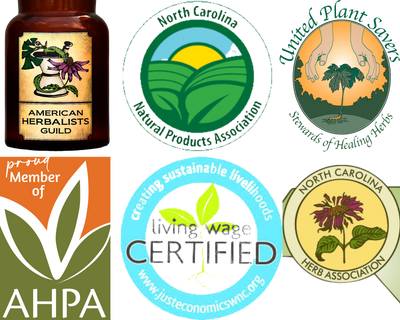The Role of Invasive Herbal Preparations: Kudzu, Mimosa, Wild Rose...Plantain? Dandelion?
Within our materia medica of common 'weedy' beneficial plants native to the Appalachian mountains where we are based, you will also find a sprinkling of so-called invasive plants which are not native to this area and at times are seen as resource hogs, taking water, sunlight, and nutrients from our native plants and sometimes depleting their populations or even choking them out. One individual, a professional whose work is to control the populations of non-native plants in our woodlands, recently posed a question to us about the harvesting and use of invasive species such as autumn olive, multiflora rose, and mimosa and how this affects their presence amidst our native plants. It's such a fascinating inquiry and important topic that we wanted to address it here. After all, we eat, sleep, and breathe plants: their future is our future and their health is our health.
Does the Use of Abundant Herbal Preparations Include Invasive Species?
Increasingly, we are finding the plants in our yards are 'foreigners', invasive species which are sometimes stigmatized and snubbed by native plant lovers. What does the presence of these exotic botanicals mean and how do we deal with their infiltration of populations of other plants that we want to see thrive?

Mimosa tree flowers (Alibizia julibrissin)
Certain invasive herbs have become quite popular in modern herbalism: Japanese knotweed is commonly included in protocols for chronic lyme and immune support, kudzu leaves are edible, spinach-like, and certainly abundant, the plant provides an incredibly tough fiber for basket-weaving, and its nutritive, starchy root is an invaluable ally for a number of physical issues, and mimosa flower goes into many mood-boosting formulas for its reputation as the serotonin-boosting 'happiness tree'.

Beyond the Idea of Good Natives vs. Bad Invasives
The framing of the invasive plant issue can be as varied as "All non-natives are bad," (see this National Geographic article on the subject) to "...The blame for damage done by so-called invasive species lies with us, when we have created an imbalance that opens opportunities for new species to move in," (Toby Hemenway on Timothy Scott's fascinating book Invasive Plant Medicine, which I recommend).

Autumn/Russian Olive berries (Eleagnus spp.)
The discussion on invasives vs. natives in the realm of modern herbalism gets complicated and nuanced quickly, with issues of sustainable wildcrafting and plant population control coming to the forefront. The average herbalist wouldn't dare refer to beloved plantain (which was known as 'English-man's foot' to indigenous Americans) or dandelion as invasive or consider eliminating them from the "materia medica" because they had origins somewhere other than North America.
To the contrary, the two weeds are present in some form in almost every materia medica and in the majority of herb shops, mirroring their prevalence throughout the planet. The complexities of invasives vs. natives in the ecosystem are immense and this doesn't even touch on the philosophical lessons that invasive plants might hold for humanity: resilience, adaptability, and thriving under difficult circumstances, to name a few. Invasive plants are scrappy and tenacious to the core - qualities that will become more and more prized as we deal with a changing planet. One thing is becoming clear, though: the hard line between the invasives and the native plans is becoming blurred.
Conventional wisdom tells us that invasive species are unwanted and insidious. But the landscape is changing; in a warming world, it is becoming increasingly challenging to define what is native and what is not. There is even an area of study within integration biology which looks at the relationship invasive and native plants have with each other. Opportunistic plants offer us the chance to respect them for what they are, appreciate the role they play, receive what they offer, and reimagine how to do this while also preserving and sustaining our native plants. This is their own unique property, whether you make it into an herbal tincture (as in Japanese knotweed or kudzu) or not (check out this NY Times article 'Invasives Aren't Always Unwanted' for more).

Why Harvesting and Using Invasive Plants as Herbal Preparations Helps Balance the Ecosystem
We promote the harvesting and use of medicinally and nutritionally valuable plants and herbs, regardless of where they originate from. Often, the appropriate use of invasives such as multiflora rose blossoms or hips or autumn olive berries can help to control, deter, and diminish their populations by preventing them from seeding or spreading further (since these hips/berries are their reproductive organs). When we harvest wild multiflora rosehips for tea, preserves, or for our award-winning Carolina Bitters digestive formula, or pick autumn olive berries as an antioxidant-rich wild snack or pie filling, we effectively reduce their chances of reseeding themselves with those particular fruits, which may give native botanicals in the area a better chance to hold their own and resist the invasive takeover.

Despite their poor reputation amongst gardeners, invasives do have value when considered part of the larger ecological web. The Albizia julibrissin tree was originally introduced to the US as an ornamental from Asia and adapts well to most soils. When we harvest the stunningly gorgeous mimosa flower and bark to make our grief-supportive and mood-optimizing Mimosa Elixir, we will often drop a branch - which may help reign in the growth of the tree - or gather blooms from a specimen that is about to be cut down or trimmed anyway. Sustainably wildcrafting the blossoms - while, of course, leaving some for pollinators and other people to enjoy - means that we are reducing the self-seeding ability of the tree and therefore future populations of mimosa, while increasing the ability of native trees to thrive.
What can be done to control the widespread growth of exotic invasives while also helping our precious native (often woodland growing) herbs such as lobelia, yellowroot, Solomon's seal, and black cohosh to thrive? Eating the weeds is a good start. We never promote the cultivation or spreading of invasive plants because their vigor and growth speed has the potential to destroy the native species that make our region of western North Carolina so special and among the most botanically diverse bioregions in the world. But we are long-time purveyors of the Frank Cook (Plants and Healers International) mantra, "Eat something wild everyday," and many of the most sought-after greens in our foraged salads are wild mustard, dandelion, plantain, and garlic mustard. Top that with some blackberries and you have yourself a fully invasive salad.
Another practice we can all do is essentially 'find and replace'. If on your outdoor adventures you see young multiflora rose, Japanese honeysuckle, oriental bittersweet, privet, Japanese barberry, or Russian olive species which are going to choke out the native botanicals at the woods' edge or in the deep forest, pull out a few of these invasives and plant a seedling of goldenseal, ginseng, bloodroot, or black cohosh in their place. Jeannie loves to do this while giving her goats the opportunity to walk with her and munch down some of these exotic invasives as they will eat whatever she pulls for them.

Weaving traditional kudzu baskets at Red Moon Herbs with the incredible teacher Nancy Basket
True Sustainability Through Education, Plant Saves, and Seed Spreading
Perhaps the deepest thread that runs through our 26-year history as a small herb company is that of protecting and spreading seeds of native plant populations. We do plant rescues and saves in which we transplant native medicinals from areas where they would otherwise be eradicated by development. We promote the awareness and use of ginseng leaf which is undervalued yet as or more potent than ginseng root. We share traditional wild-tending strategies such as re-planting pieces ginseng and Solomon's seal roots and planting the berries/seeds before harvesting. We pride ourselves on being leaders in the seed-spreading revolution.
Intrigued with the subject and looking for more? For further reading, check out the thoroughly researched book Invasive Plant Medicine: The Ecological Benefits and Healing Abilities of Invasives. Look into Ann Armbrecht's work on the Sustainable Herbs Project. Support your hyper-local or as-local-as-possible organic and biodynamic farmers, wildcrafters, and herbalists and know your herb sources and #whogrewyourherbs. And as always, join us in supporting the work of United Plant Savers to conserve and protect our precious native medicinal plants.







